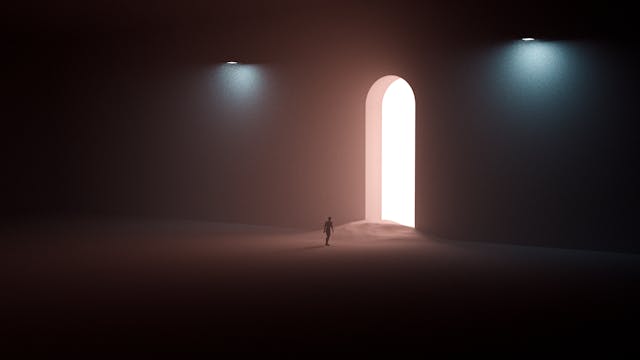JD ของตำแหน่งงาน 3D Animator มักจะระบุความต้องการของพนักงานที่มีความสามารถและประสบการณ์ในการสร้างและพัฒนาภาพเคลื่อนไหว 3 มิติสำหรับโปรเจคต่าง ๆ รวมถึงเกม, ภาพยนตร์, และโฆษณา ผู้ที่สนใจจะต้องมีความคิดสร้างสรรค์และมีทักษะด้านเทคนิคที่ดีเยี่ยม

Photo by Mo Eid: https://www.pexels.com/photo/person-in-black-shirt-walking-on-sand-8347501/
ตัวอย่าง Job Description ของตำแหน่งงาน 3D Animator:
1. Conceptualize and design:
พัฒนาแนวคิดสำหรับการออกแบบตัวละคร, อุปกรณ์ประกอบฉาก และสภาพแวดล้อมตามบท, สตอรีบอร์ด หรือคำสั่งการ
2. Modeling:
สร้างโมเดลสามมิติของตัวละคร, วัตถุ และสภาพแวดล้อมโดยใช้ซอฟต์แวร์ออกแบบด้วยคอมพิวเตอร์ (CAD) หรือเครื่องมือทำโมเดล 3D เช่น Maya, Blender, หรือ ZBrush
3. Texturing and shading:
ใส่พื้นผิว, สี และเอฟเฟกต์แสงให้กับโมเดล 3D เพื่อให้มีความสมจริง
4. Animation:
ใช้เทคนิคแอนิเมชันแบบคีย์เฟรมเพื่อสร้างการเคลื่อนไหว, ท่าทาง และการแสดงอารมณ์สำหรับตัวละครและ objects ต่างๆ
5. Lighting:
ตั้งค่าและปรับแสงในสภาพแวดล้อม 3D เพื่อสร้างบรรยากาศ, ความลึก ให้สมจริง
6. Compositing:
รวม elements หลายๆอย่าง (เช่น โมเดล 3D, ฟุตเทจการถ่ายทำจริง หรือภาพวาดแมต) เข้าด้วยกันในเฟรมเดียวโดยใช้ซอฟต์แวร์รวมองค์ประกอบ เช่น Nuke หรือ After Effects
7. Visual effects:
สร้าง realistic simulations of natural phenomena, เช่น ไฟ, น้ำ, ควัน หรือการระเบิด โดยใช้ dynamics and physics-based tools.
8. Collaboration:
ร่วมงานกับผู้กำกับ, โปรดิวเซอร์, ผู้กำกับศิลป์ และศิลปินคนอื่น ๆ เพื่อให้แน่ใจว่าสไตล์ภาพและรูปลักษณ์โดยรวมสอดคล้องกับวิสัยทัศน์ของพวกเขา
9. Problem-solving:
แก้ไขปัญหาทางเทคนิค, ปรับปรุงประสิทธิภาพ และตัดสินใจทางสร้างสรรค์เพื่อตอบสนองต่อกำหนดเวลาและข้อกำหนดของโครงการ
10. Rendering:
ช้ซอฟต์แวร์การเรนเดอร์ เช่น V-Ray, Arnold, หรือ Cycles เพื่อสร้างภาพหรือแอนิเมชันคุณภาพสูงจากฉาก 3D
การมี Job Description ที่ละเอียดและชัดเจนช่วยให้ผู้สมัครสามารถเข้าใจถึงความคาดหวังและหน้าที่ของตำแหน่งงานได้ดีขึ้น ช่วยในการคัดเลือกผู้สมัครที่เหมาะสม และเป็นมาตรฐานในการประเมินผลการทำงานในอนาคต
ตัวอย่าง KPI ของตำแหน่งงาน 3D Animator
1. On-time delivery rate:
Percentage of projects completed on or before the scheduled deadline.
2. Quality rating:
Average score given by clients or internal stakeholders for the quality of animation work produced.
3. Turnaround time:
Time it takes to complete a project from start to finish, measured in days or weeks.
4. Client satisfaction rate:
Percentage of clients who are satisfied with the final product and the overall experience working with the 3D animator.
5. Project complexity index:
Measure of the complexity of projects taken on, including factors like number of characters, scenes, and special effects.
6. Cost efficiency ratio:
Ratio of project costs to revenue generated from completed projects.
7. Time-to-market:
Time it takes for a new animation product or feature to be developed and released to the market.
8. Error rate:
Percentage of errors or defects in animations that require rework or correction.
9. Style consistency:
Measure of how well the 3D animator maintains a consistent visual style throughout their work.
10. Innovation metrics:
Number of new techniques, tools, or software learned and applied to projects, which can indicate creativity and adaptability.
ตัวอย่าง Job Description และ KPI ของตำแหน่ง 3D Animator
Job Description: 3D Animator
ตำแหน่ง: 3D Animator
แผนก: การออกแบบ / การผลิต / สื่อดิจิทัล
รายงานต่อ: ผู้จัดการฝ่ายผลิตภัณฑ์ / ผู้กำกับฝ่ายออกแบบ
สถานที่ทำงาน: สำนักงาน / ทำงานจากที่บ้าน (ตามความเหมาะสม)
หน้าที่และความรับผิดชอบ:
- ออกแบบและสร้างการเคลื่อนไหวของโมเดล 3D:
- ใช้ซอฟต์แวร์ 3D เช่น Autodesk Maya, Blender หรือ 3ds Max เพื่อสร้างการเคลื่อนไหวของตัวละคร, วัตถุ หรือสภาพแวดล้อม
- ทำการออกแบบท่าทางการเคลื่อนไหว (motion) และการเปลี่ยนแปลงทางกายภาพ (physical deformation) ให้สมจริงและน่าสนใจ
- ตรวจสอบการเคลื่อนไหวที่สร้างขึ้นให้ตรงกับวิสัยทัศน์และความต้องการของโปรเจกต์
- ร่วมงานกับทีมออกแบบและผู้กำกับ:
- ประสานงานกับทีมงานที่รับผิดชอบด้านการออกแบบและการผลิต (เช่น Art Directors, VFX artists, Lighting Artists) เพื่อให้ได้ผลลัพธ์ที่เหมาะสม
- รับคำแนะนำและข้อเสนอแนะจากผู้กำกับหรือหัวหน้าฝ่ายการผลิต เพื่อปรับปรุงและแก้ไขการเคลื่อนไหวที่ไม่ตรงกับความต้องการ
- การสร้างเทคนิคการเคลื่อนไหวที่หลากหลาย:
- สร้างการเคลื่อนไหวที่หลากหลาย เช่น การวิ่ง, การต่อสู้, การพูด, การบิน และการกระทำที่หลากหลายตามลักษณะของตัวละครหรือโปรเจกต์
- ทำงานกับผู้กำกับและทีมงานเพื่อให้การเคลื่อนไหวเป็นไปตามสคริปต์และบรรยากาศของโปรเจกต์
- การใช้ซอฟต์แวร์และเทคนิคการเคลื่อนไหวใหม่ๆ:
- เรียนรู้และทดลองใช้เทคโนโลยีใหม่ๆ ในการทำแอนิเมชัน 3D เช่น การเคลื่อนไหวแบบ motion capture, การใช้ฟิสิกส์ในการจำลองการเคลื่อนไหว (physics-based simulation)
- ปรับปรุงทักษะในการใช้เครื่องมือที่มีประสิทธิภาพสูงขึ้น เพื่อเพิ่มประสิทธิภาพในการทำงานและคุณภาพของแอนิเมชัน
- การทดสอบและปรับแต่งแอนิเมชัน:
- ทดสอบการเคลื่อนไหวในฉากต่างๆ เพื่อตรวจสอบความสมจริงและการทำงานร่วมกับส่วนอื่นๆ ของโปรเจกต์
- ปรับแต่งการเคลื่อนไหวตามข้อเสนอแนะและความต้องการของทีมงาน เพื่อให้ได้ผลงานที่ดีที่สุด
- การทำงานภายใต้กรอบเวลาที่กำหนด:
- ปฏิบัติงานตามกำหนดเวลาที่ตกลงกันไว้โดยไม่กระทบกับคุณภาพของผลงาน
- จัดลำดับความสำคัญของงานที่ได้รับมอบหมายและรับผิดชอบในการทำงานให้เสร็จตามกำหนดเวลา
KPI (Key Performance Indicators) สำหรับตำแหน่ง 3D Animator
- คุณภาพของแอนิเมชันที่สร้างขึ้น
- การเคลื่อนไหวที่สร้างขึ้นต้องมีความสมจริงและเป็นไปตามมาตรฐานของโปรเจกต์
- การสร้างแอนิเมชันต้องตอบสนองความต้องการของผู้กำกับ และสามารถแก้ไขปรับปรุงได้ตามฟีดแบ็ก
- การเสร็จสิ้นตามกำหนดเวลา
- ทำงานให้เสร็จภายในระยะเวลาที่กำหนด ตามกำหนดการของโปรเจกต์หรือการสั่งงานจากผู้จัดการฝ่ายผลิต
- ต้องไม่เกิดความล่าช้าในกระบวนการผลิตที่มีผลกระทบต่อขั้นตอนถัดไป
- การทำงานร่วมกับทีม
- ความสามารถในการทำงานร่วมกับทีมออกแบบ, ผู้กำกับ, และฝ่ายอื่นๆ ได้ดี รวมถึงการรับฟังความคิดเห็นและปรับปรุงการทำงานให้ดีขึ้น
- ความสามารถในการให้คำแนะนำหรือความคิดเห็นสร้างสรรค์ในการพัฒนาแอนิเมชัน
- การพัฒนาทักษะและเรียนรู้เครื่องมือใหม่ๆ
- ความสามารถในการใช้เครื่องมือใหม่ๆ เช่น การใช้ motion capture หรือฟิสิกส์ในการสร้างการเคลื่อนไหว
- การพัฒนาทักษะในการใช้ซอฟต์แวร์ใหม่ๆ อย่างต่อเนื่อง เช่น การอัพเดตความสามารถในการใช้เครื่องมือที่ใช้ในอุตสาหกรรม
- การรับประกันคุณภาพในการทดสอบแอนิเมชัน
- การตรวจสอบแอนิเมชันทุกชิ้นก่อนที่จะส่งมอบงานให้ผู้กำกับหรือทีมงาน
- ตรวจสอบข้อผิดพลาดในการเคลื่อนไหว เช่น ความผิดปกติในการเคลื่อนไหวหรือการไม่สมจริงในการแสดงออก
- การจัดการทรัพยากร
- การใช้เวลาทำงานและทรัพยากรในโปรเจกต์อย่างมีประสิทธิภาพ เช่น การใช้เวลาในการปรับปรุงแอนิเมชันและการจัดการกับข้อจำกัดทางเทคนิค
สนใจทดลองใช้งานโปรแกรมประเมินออนไลน์ EsteeMATE ติดต่อได้ที่นี่